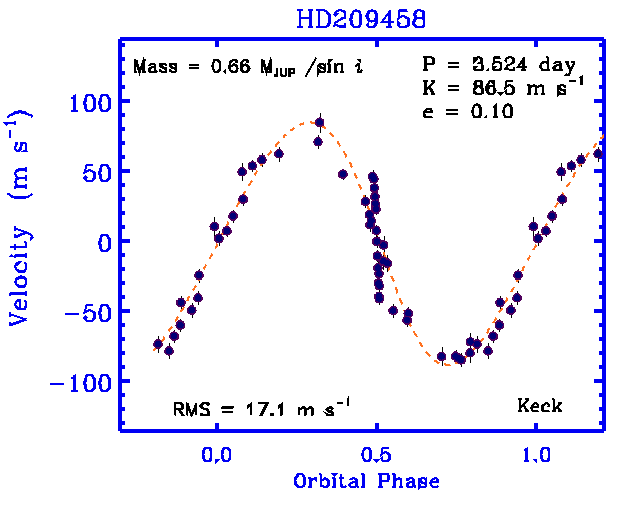
 Copyright © Michael Richmond.
This work is licensed under a Creative Commons License.
Copyright © Michael Richmond.
This work is licensed under a Creative Commons License.
On March 22, 2005, press releases announced that the Spitzer Infrared Space Telescope had made a great discovery:

The first sentence of the Spitzer press release was
NASA's Spitzer Space Telescope has for the first time captured the light from two known planets orbiting stars other than our Sun.
But what really happened? In a nutshell,
Let's look a bit more closely at these two star systems. The planet around HD 209458 was first noticed back in 1999, when astronomers measured a periodic change in the radial velocity of its host star.

This indicates that the star is moving towards and away from us gently with a period of about 3.5 days; the simplest explanation is that a planet is tugging it as it orbits the star.
The presence of a planet was confirmed when astronomers monitoring the brightness of this star found a very slight decrease in its light at just the time that the planet was passing in front of the star.

Based on the size of the dip, astronomers can calculate the relative sizes of the star and the planet; and, since they know the rough size of the star, we can figure out the size of the planet.
The planet in the other stellar system in the news, TrES-1, was discovered by the "transit" technique. We have measured the small dip in brightness as the planet passes in front of its star from the RIT Observatory:

Note the size of the effect: in both cases, the planet blocked about 1.5 percent of the star's visible light, indicating that
Okay, so what's all the hubbub? What the Spitzer telescope did was to watch these two systems over several hours as the planets passed behind the host star.

These light curves show that the planet provides a very small fraction of the total infrared light of the systems: about 0.25 percent of the total. Compare that to the roughly 1.5 percent of the star's visible light which the planets blocked. The dip in brightness that you see in these graphs is what is meant by the press release text
NASA's Spitzer Space Telescope has for the first time captured the light from two known planets orbiting stars other than our Sun.
The "missing" infrared light from the planets is a combination of starlight reflected from the cloudtops, plus light emitted by the warm planet itself. The two groups which made the observations have used modelled the data to estimate the temperatures of the planets in these systems:
Since the planets are both very close to their sun-like host stars, these high temperatures are not surprising.
 Copyright © Michael Richmond.
This work is licensed under a Creative Commons License.
Copyright © Michael Richmond.
This work is licensed under a Creative Commons License.